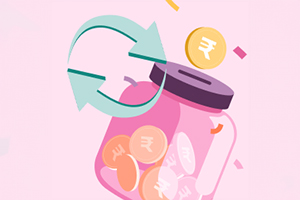Fixed Deposits are a popular financial savings tool that provides guaranteed returns at attractive interest rates.
Whether you aim to set aside funds for an upcoming vacation or save for your child's education a decade down the
line, Fixed Deposits offer a reliable means to fulfil your financial aspirations.
However, choosing between short-term FDs and long-term FDs can be crucial, as they impact both returns and liquidity.
What is a short-term Fixed Deposit?
As the name suggests, a short-term Fixed Deposit is for a shorter period, ranging from 7 days to 1 year. The interest
rate offered on a short-term FD is higher than the Savings Account interest rate. Typically, the rate of interest is
between 3% and 6%.
If you have excess funds that you don't require immediately, but foresee an expenditure in the next few months, it is
best to go for a short-term FD. It will generate higher interest than funds just parked in your Savings Account.
What is a long-term Fixed Deposit?
A long-term Fixed Deposit has a longer tenure, starting from 1 year to a maximum of 10 years. Generally, you can get
an interest rate starting at 6%. It offers a higher interest rate than the Savings Account and the short-term Fixed
Deposit.
You should consider choosing a long-term FD spanning 5 or 10 years according to your financial goals, such as saving
for your child's higher education or marriage, retirement savings, or purchasing a home. Long-term FDs are more
secure than equity-related instruments, which entail more risk.
Differences between long-term FD and short-term FD
| Parameter |
Short-term FD |
Long-term FD |
| Tenure range |
7 days to 1 year |
1 year to 10 years |
| Interest rates |
Generally, higher interest rates than the Savings Account but lower than long-term FD |
Higher interest rates than short-term FD |
| Taxation |
If interest income exceeds ₹40,000, TDS is applicable at 10% (₹50,000 for senior
citizens).
TDS can be avoided by submitting form 15G/H to the bank if your annual income is
below ₹2.5 lakh. |
If interest income exceeds ₹40,000, TDS is applicable at 10% (₹50,000 for senior
citizens).
TDS can be avoided by submitting form 15G/H to the bank if your annual income is
below ₹2.5 lakh. |
| Safety |
Highly secure |
Highly secure |
| Liquidity |
Offers liquidity, enabling easy access to funds due to shorter tenure subject to premature
withdrawal charges, if any |
Limited liquidity owing to the prolonged lock-in period. While premature withdrawal from a Fixed
Deposit is permitted, it incurs a penalty and impacts the applicable interest rate |
| Purpose |
Best suited for short-term financial goals |
Best suited for long-term financial goals |
| Wealth accumulation |
Not suited for building a corpus and long-term wealth growth |
Best suited for accumulating wealth over a period of time |
| Opportunity cost |
Lower opportunity cost since the funds are available to be reinvested sooner |
Higher opportunity cost as the funds are not available for a longer duration |
| Goal alignment |
Ideal for short-term financial requirements like a down payment for car |
Ideal for long-term financial goals like buying a house or retirement saving |
Build a good financial plan using short-term and long-term FDs
You must make a solid financial plan to generate maximum income from investments. While equity instruments lure
investors with potentially higher returns, they also come with an inherently high-risk factor. Therefore, Fixed Deposits present a
safer choice, offering you decent returns with minimal risk.
In this debate of short-term FD vs long-term FD, you can choose both in combination. A smart investment strategy
involves having a mix of both in your investment portfolio to reap the maximum benefit. Suppose you have ₹5 lakh in
your Savings Account and plan to invest it further. However, you anticipate an expenditure of ₹1 lakh in the next 6
months. So, in such a scenario, it would be best to make a short-term FD of 6 months of ₹1 lakh and opt for a
long-term FD of 5 years for the rest ₹4 lakh. Alternatively, you can also make four Fixed Deposits of ₹1 lakh each
with different tenures ranging from 3 to 5 years. This diversified approach offers enhanced flexibility and
potential benefits for your investments.
What to choose between short-term and long-term FD?
The main difference between a short-term FD and a long-term FD is the duration of the Fixed Deposit. Your choice
between a short-term FD and a long-term FD should be based on how quickly you need the funds again. If your
investment horizon is longer than one year, opt for a long-term FD. Conversely, if you foresee you will require the
money in less than a year, opt for a short-term FD.
Consider a situation when you make a long-term FD of 5 years. After 3 months, you need money to buy a gift for a
family member. You might have to break your FD and lose out on the potential interest. Similarly, if you make a
short-term FD of 6 months and do not require the funds after maturity, you will lose out on the higher interest
offered by the long-term FDs. Therefore, a well-balanced strategy is essential to align your investment decision
with your investment horizon.
Regardless of your choice, you can open both FDs online easily and take advantage of facilities like auto-renewal or
premature closure as per your need.
Also Read: What
is Fixed Deposit laddering and how does it work?
Conclusion
Both short-term FD and long-term FD are great options for a safe and steady investment with assured returns. Choose a
short-term FD if you require the funds in a short time or if you expect interest rates to increase shortly.
Conversely, go for a long-term FD if you don't need the funds immediately or anticipate a decline in the interest
rates.
With Axis Bank Fixed Deposit, you have the flexibility to choose your preferred tenure and earn an assured return at
an attractive interest rate, starting with a minimum amount of just ₹5,000!
Disclaimer: This article is for information purpose only. The views expressed in this article
are personal and do not necessarily constitute the views of Axis Bank Ltd. and its employees. Axis Bank Ltd.
and/or the author shall not be responsible for any direct / indirect loss or liability incurred by the reader
for taking any financial decisions based on the contents and information. Please consult your financial advisor
before making any financial decision.







